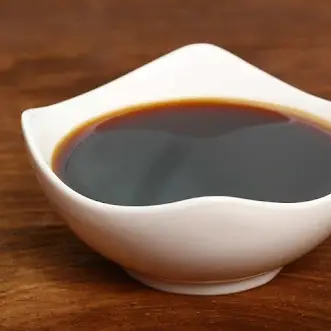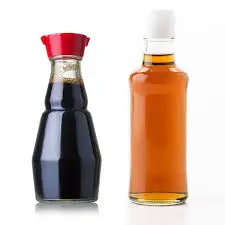Introduction
To add flavor to your meals, especially Asian dishes, use soy sauce or ponzu. They are popular choices. At first glance, they might seem similar, but they have some key differences.
Ponzu vs Soy Sauce: What’s Your Pick? If you’ve ever wondered what sets these two sauces apart. And how you can use them in your cooking, you’re in the right place. Let’s explore each sauce’s unique qualities and how people make them. Then, we’ll see how to use them to enhance your food’s flavor.
Difference Between Ponzu vs Soy Sauce?
What is ponzu sauce?


Ponzu sauce is a special sauce from Japan that has a bright, tangy flavor. Mix citrus juice (such as yuzu, sudachi, or lemon) with soy sauce to make this sauce. It also includes mirin, a sweet rice wine, dashi, a Japanese soup stock, and sometimes a bit of vinegar. This mix creates a sauce that tastes a bit sour, sweet, and savory all at the same time.
Ingredients in Ponzu Sauce:
- Citrus Juice: The main flavor of ponzu comes from citrus fruits like yuzu or lemon, which give it a tangy taste.
- Soy sauce adds a salty and rich flavor that balances out the citrus.
- Mirin: A sweet rice wine that adds a touch of sweetness.
- Dashi: A savory stock made from seaweed and fish flakes that gives the sauce a deep flavor.
- Vinegar: Sometimes used to make the sauce even tangier.
How is ponzu sauce made?
Making ponzu sauce is very simple. You mix citrus juice, soy sauce, mirin, and dashi. Then, let the mixture sit so all the flavors blend well. We warm the sauce to blend the flavors. It’s usually served cold or at room temperature, though.
What is soy sauce?


Many Asian dishes use soy sauce, a well-known condiment originating from China. It’s made by fermenting soybeans, wheat, salt, and water. This process gives soy sauce a rich, salty flavor with a hint of sweetness. Soy sauce offers versatility and enhances many different types of recipes.
Ingredients in soy sauce:
Ingredients
How is soy sauce made?
Making soy sauce takes some time. First, cook soybeans and mix them with roasted wheat. Then, we add a special mold to start the fermentation. It depends on the type of soy sauce. People leave this mixture in a salty liquid (brine) to ferment for months or years. After this long process, we squeeze out the liquid, heat it, and then bottle it.
Ponzu vs. Soy Sauce: The Main Differences
Let’s look at how ponzu and soy sauce differ:
- Flavor Profile:
Ponzu Sauce: Blends citrus zest with savory, sweet, and acidic notes.
Soy sauce: rich and salty, with a deep, savory taste and a bit of sweetness.
- Ingredients:
Ponzu Sauce: Made with citrus juice, soy sauce, mirin, dashi, and sometimes vinegar.
Soy Sauce: Made from fermented soybeans, wheat, salt, and water.
- Culinary Uses:
Ponzu Sauce: Often used as a dipping sauce for raw fish (like sashimi), grilled meats, or vegetables. It is also good as a salad dressing or a marinade for fish.
Soy Sauce: It’s very versatile. Use it in marinades, stir-fries, soups, and as a dipping sauce for sushi and dumplings.
Origin:
- Ponzu Sauce: Comes from Japan, influenced by Dutch and Portuguese traders.
- La salsa de soya: se originó en China y ha estado presente durante más de 2,500 years.
- Texture:
- Ponzu Sauce: Thin and light, like a salad dressing.
- Soy Sauce: Thicker and more syrupy, especially in some varieties like dark soy sauce.
How to Use Ponzu and Soy Sauce
Both sauces are useful, but they shine in different ways. Here’s when to use each one:
- Ponzu Sauce: Its bright, tangy taste is great for dishes that need a refreshing lift. Use it for dipping raw fish, grilled seafood, or cold noodles. It’s also a nice salad dressing, especially for salads with seafood or tofu.
Popular Ponzu Dishes:
- Sashimi (raw fish)
- Grilled seafood
- Cold noodles
- Seafood or tofu salads
- Shabu-shabu (hot pot)
- Soy Sauce: With its rich, salty flavor, soy sauce is very versatile. It’s perfect for marinades, stir-fries, and soups. It’s also great as a dipping sauce for sushi and other dishes.
Popular Soy Sauce Dishes:
- Sushi
- Stir-fries
- Marinades for meat.
- Soup broths
- Noodle dishes, like ramen or udon.
Nutritional Differences
Here is the rewritten text:
They exhibit distinct nutritional profiles in these ways:
- Calories: Ponzu sauce usually has fewer calories because of its citrus juice.
- Sodium: Both sauces are salty, but soy sauce usually has more sodium. If you need to cut back on salt, ponzu might be a better choice.
- Sugar: Ponzu might have more sugar due to the mirin, while soy sauce has very little sugar.
Can you swap them?
Sometimes, you might want to swap one for the other in recipes. Remember that ponzu’s tangy flavor can change the taste of your dish a lot. It works well in recipes that can handle a bit of acidity. Using soy sauce instead of ponzu will make your dish saltier and less tangy.
So, next time you’re in the kitchen, keep these differences in mind. Knowing when to use ponzu and when to use soy sauce can help make your dishes taste amazing.



